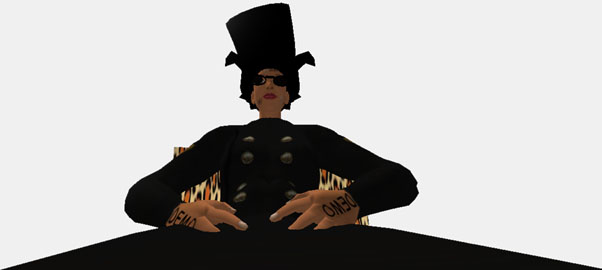

Gazira Babeli
Code Performer
| Can we understand avatars, or one another, for that matter? |
| Patrick Lichty, September 2009 |
|
An avatar sits in a room, alone. The walls are charcoal gray, the floors ashen cypress plank. She sits before a screen, with people appearing on it, gesticulating, drawing pictures, and mumbling through the window. In return, the avatar, in this case, one without an operator, tries to respond. One could almost imagine the huge sound/light array from "Close Encounters of the Third Kind" in the background, and the only thing missing is the sign language. But in this case, one might be led to ask who is the interpreter, and who is the alien, and whether there is any hope for understanding... For Gazira Babeli's "Talking with Aliens" (2009, Ljubiana, Slovenia), native "code artist" Babeli isolates herself in a cubicle, with the only link to the outside world being a video window connected to a webcam into a gallery in Slovenia. Both the subject and object are placed out of context, and are left across the table from one another, left to try to make a connection with one another. What we are left with is the primordial reflection of the Other in each other's eyes, and forced to resolve the matter, what emerges from the dialogue? Talking with an alien requires untold layers of translation through endless social protocols, representations, and local grammars (tools, gestures) as well as metastructures like written languages. For this installation, one might be inclined to give up hope, as Gazira is as opaque as any character on any screen. There are concessions that Gazira has that make the situation hopeful. She will talk to you; she will try to reach out to you. But will you understand one another, or is the entire exercise like trying to understand the idioglossia (secret language) between twins from the outside? Is it like trying to determine whether Schroedinger's Cat is still alive without opening the box? There are come concessions to this in that all con-versants possess a more or less human form, use anthropomorphized, and share a written language using a latin character set. There are already a myriad of commonalities between you and Gazira that it seems that one may not need a Rosetta Stone. If you draw a cat, she might know it is a cat. If you wave, she may wave back. There is already some groundwork in place when one includes the similarity of language devices, embodied form, and so on. But recent discoveries in animal cognition reveal that the gulf between us is wider than we ever imagined. Throughout the 1990's Irene Pepperberg has been doing groundbreaking work in the area of animal cognition with her gray parrot Alex. She learned that Alex was able to understand the concept of zero, which is hard for some children, and express fear of predators outside the house even with the blinds closed, which reveals abstract thought. In addition, Temple Grandin's work with animal consciousness and autism in her design of more humane slaughterhouses proves how little human beings understand about the consciousness of other beings, or one another, for that matter. You know, when I look into my little Siamese cat's eyes, I know there's a thought process there. I have learned her clicks and trills, and although we are of a common culture, but have different languages and different types of consciousness, we have learned to translate, and we have an understanding. But the fact that after tens of thousands of years of civilized development, we have only now begun to learn that other beings on our earth think and feel is nothing less than the realization that African natives were indeed human, and their art entered art museums rather than natural history museums. As a species, humanity has a long way to go. And when confronting an obviously advanced species as Gazira (Homo Virtualis), will she consider you human? I know her well enough to think that she will. Returning to the black room, the negotiation continues. Gazira shows a stick figure drawing of a boy under a sun, the person on the other side of the screen, shows a picture of a cat. An anvil falls from the sky inside the room. What was that? Nohing - don't worry... Let's keep talking. |
Back to TEXTS |
